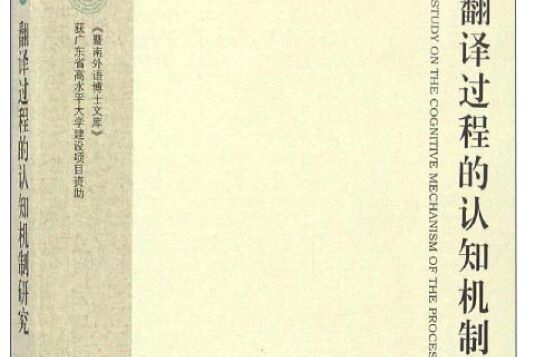《翻譯過程的認知機制研究》是2016年世界圖書出版公司出版的圖書,作者是顏方明。
基本介紹
- 書名:翻譯過程的認知機制研究
- 作者:顏方明
- 出版社:世界圖書出版公司
- 出版時間:2016年11月1日
- ISBN:9787519218508

《翻譯過程的認知機制研究》是2016年世界圖書出版公司出版的圖書,作者是顏方明。
《翻譯過程的認知機制研究》是2016年世界圖書出版公司出版的圖書,作者是顏方明。內容簡介《翻譯過程的認知機制研究》從認知範疇化視角提出,翻譯過程是譯者對原作的再認知過程,是對原作範疇化概念集合的一種再範疇化。我們可以從宏...
口譯過程認知是近年來比較熱門的研究領域,口譯過程包括信息輸入、信息加工與信息輸出幾個基本的階段,每個階段下又分為不同的子階段,這些認知過程研究會最終揭示口譯過程語言轉換這個黑匣子,源語轉換到目的語的過程是語言認知的研究的核心內容,會為未來機器翻譯和信息技術發展提供科學的支撐。該書分為口譯過程的信息...
《翻譯認知過程研究》是2020年外語教學與研究出版社出版的圖書。內容簡介 《翻譯認知過程研究》致力於融合兩種研究範式,對翻譯認知過程研究的理論、方法和前沿問題進行系統梳理和綜合探討。全書共分為六章。第一章明確翻譯認知過程研究的認知翻譯學學科框架;第二章評述翻譯認知過程的各類研究方法;第三章基於認知翻譯學...
《文學翻譯的認知研究》是2023年中南大學出版社出版的圖書。內容簡介 文學翻譯也是一種人類認知活動,可以用認知語言學理論來解釋翻譯過程,從而合理地解釋源語和目的語之間是如何聯繫及翻譯的創造性等問題,《文學翻譯的認知研究》從翻譯的認知角度,為翻譯研究提供了新視角。全書分為六章,內容涉及多重概念整合視域下...
《口譯認知研究:同聲傳譯與工作記憶的關係》一書以英漢雙語同聲傳譯為研究背景,借鑑認知心理學、心理語言學中語言信息處理、記憶資源配置等原理,套用實驗法、調查法、觀察法等多種實證研究方法,同時採用歷時描述與共時對比相結合的研究設計,力求對同聲傳譯與工作記憶的關係進行全面而深入的考察與分析,並在此基礎上...
《基於全媒體的口譯認知研究》是2021年中國社會科學出版社出版的圖書,作者是孫傑。內容簡介 首先從定義、歷史、特點和模式方面對口譯進行比較綜合的介紹,據此針對口譯認知過程的階段、模型、精力分配和所需技能等進行梳理,釐清口譯認知的本質,並以之為基礎總結譯員職業化的素養、行為準則和角色等素質。繼而依據前文...
《跨越語言的識解:翻譯的認知語言學探索》是以認知語言學為視角對翻譯現象進行的一項系統研究。它吸收了關聯翻譯論和翻譯圖示研究的成果,結合認知語言學的基本理論假設,創建了翻譯中意義建構的認知模式。《跨越語言的識解:翻譯的認知語言學探索》以“識解”作為文本對比分析的中介概念,刻畫了具體翻譯中涉及的多樣化認知...
《認知視閾下的語言與翻譯研究》是2012年9月中國社會科學出版社出版的圖書,作者是侯敏。內容簡介 《認知視閾下的語言與翻譯研究》內容豐富,主要包含了客觀主義語言學與非客觀主義語言學、客觀主義的主要觀點和特徵、非客觀主義的主要觀點和特徵、傳統語言學哲學觀與當代認知語言學哲學觀的對比、認知語言學模式下的翻譯...
《莫言小說英譯的體認心理研究》將體認觀與心理學相結合,研究莫言小說葛浩文英譯本(簡稱葛譯本)中各種認知範疇英譯的運作機理,旨在建構一系列可闡述、可印證的翻譯體認心理機制。圖書目錄 第一章 翻譯體認心理學概論 第一節 翻譯體認觀溯源 一、體認觀的哲學淵源 二、體認觀的認知科學理論依據 三、翻譯的體認觀 ...
《認知視野下的翻譯研究》吸收借鑑認知理論有關語言認知的研究成果,從認知的角度闡述了翻譯的本質問題,提出了翻譯認知觀,並佐證其合理性;在翻譯認知觀的視域下,探討了翻譯的主體問題一主體.主體性。主體間性、翻譯主體能力結構與行為認知的構擬、翻譯過程:理解與表達、思維認知與翻譯、隱喻思維認知與翻譯、意象認知...
《視閱口譯的認知研究》是2017年中國海洋大學出版社出版的圖書。內容簡介 《中國外語研究學海文叢:視閱口譯的認知研究》分5章,在認知和心理語言學理論框架下探究英漢視譯這一複雜的認知活動過程中閱讀理解、意義單位、注意力的分配、預測、斷句和靈活整合的合理性和形成機制,對“順句驅動和邊閱讀邊翻譯”的機製作...
“翻譯與語言認知研究叢書”旨在推進語言人才培養,提升培養語言服務人才的師資水平並增強語言服務人才的自身能力。基於此,“翻譯與語言認知研究從書”設計了四個分冊:《語言認知技術研究》、《口譯過程認知研究》、《口譯認知理論研究》和《口譯焦慮認知研究》。《口譯認知理論研究》詳細介紹了西方口譯認知理論,把經典的...
《辭彙翻譯的認知探索》是2016年科學出版社出版的圖書,作者是王柳琪、劉紹龍。內容簡介 本書是筆者和團隊成員在數年探索和實證調研基礎上奉獻的一項關於翻譯和認知的跨學科研究成果。理論探索篇介紹和探討了相關認知理論(模型)及其視域下的辭彙翻澤過程及理淪思想,幫助讀者了解和掌握與翻譯認知過程密切相關的跨學科...
內容簡介:本書以翻譯認知能力為研究對象,從認知語言學的視角研究翻譯能力構建。從能力的基本定義與評價手段入手,論述了翻譯能力與其他能力之間的共性和差異,指出翻譯能力研究的認知發展趨向。基於翻譯認知能力界說,主要描述了翻譯認知能力的理論來源、概念範疇、理論機制、性質特點以及核心概念。此外,本書描述了翻譯...
《口譯焦慮認知研究》是2019年9月中國人民大學出版社出版的圖書,作者是王建華。內容簡介 口譯過程伴隨著譯員的焦慮過程,任何的同聲傳譯和互動傳譯都涉及到譯員對主題的熟悉程度,尤其是口譯的新手在遇到不熟悉的口譯任務時往往會表現出焦慮感,焦慮會導致譯員口譯水平發揮不盡人意,如何消除譯員的焦慮,本書從提升...
第2章認知視角的翻譯過程研究 第3章框架理論與框架理論視角的翻譯研究 第4章框架的定義及其基本屬性 第5章翻譯中的框架操作模式 第6章中國古詩英譯中的框架操作 第7章框架操作與中國古詩英譯中的視覺化 第8章框架操作與譯者選擇:《天淨沙·秋思》多譯本分析 第9章框架操作模式與中國古詩英譯基本問題 結語 參考...
第一章 認知翻譯學:翻譯研究的新範式 第二章 範疇化與翻譯 第三章 概念隱喻與翻譯 第四章 概念轉喻與翻譯 第五章 多義性與翻譯 第六章 象似性與翻譯 第七章 主觀性與翻譯 第八章 框架與翻譯 第九章 認知識解與翻譯 第十章 概念整合與翻譯 第十一章 關聯理論與翻譯 第十二章 語篇認知與語篇翻譯...
《漢英翻譯與跨語認知》是2009年南京大學出版社出版的圖書,作者是劉華文。本書的前九章主要集中在對漢英翻譯過程中語義和句法兩個層面的認知轉化特徵的研究和探討上。內容簡介 《漢英翻譯與跨語認知》第十章也是最後一章將兼顧語義、句法和語用三個層面,通過考察包括形容詞和副詞這些修飾語的語義指向(semantic ...
修辭認知是廣義修辭學中的一個概念,本研究把其移植到翻譯研究中,不僅對修辭認知進行了合理的界定(原型視角),並且根據其在翻譯研究中的特殊性,提出了很多新觀點,包括修辭認知的三大轉換模式、轉換動因、轉換效果等。通過重審翻譯過程中的認知型修辭格(修辭認知),不再局限於就技巧談技巧,而是和修辭詩學(文本...
作者提出的聽辨認知連通原則、脫離語言外殼的記憶發生機制以及口譯表達的動態順應策略都有不錯的創新,對口譯研究和實踐都有較好的指導作用。 作者簡介 賴禕華,博士,教授,碩士生導師。現任職於南昌大學外國語學院,兼任江西省翻譯協會副秘書長,民盟江西省委青年委員會副主任委員。在涉外企事業單位長期從事口筆譯實踐...
《法律術語的認知與翻譯研究》是復旦大學出版社出版圖書。內容簡介 《法律術語的認知與翻譯研究》以英漢法律術語為語料,探討了法律術語的來源和特徵、法律術語構詞法、法律術語之間的語義關係;在探討法律術語語義演變方式的基礎上,從認知語言學視角探討了法律術語語義演變的隱喻和轉喻認知機制,以及認知語言學的典型範疇...
第4節 學生翻譯過程巾直澤、意譯的認知轉換 第5節 進一步語料分析 第3章 程式性性翻譯能力研究:動態性 第1節 動態翻譯研究簡述 第2節 認知視角下對翻譯動態研究的重新定位 第3節 學生譯者動態翻譯情況數據統計 第4節 學生動態翻譯過程的認知假設 第5節 進一步語料分析 第6節...
《翻譯認知心理學》主要內容包括:翻譯心理學概論、翻譯認知心理學的理論基礎與研究方法、翻譯認知加工系統、翻譯思維、翻譯理解的認知本質、辭彙理解、句子理解、語篇理解、翻譯表達的認知本質、翻譯表達等。作者簡介 顏林海,男,1965年生,四川遂寧人,四川師範大學外國語學院副教授。1988年畢業於重慶師範大學外語系,...
《超越文化斷裂·翻譯學研究模式1:文本與認知的譯學研究(翻譯研究文庫)》是由英國曼徹斯特大學科技學院講師、翻譯與跨文化研究中心碩士課程指導教師梅芙·奧洛漢主編的一本論文集,共收錄了來自歐、美、澳以及其他國家與地區譯學研究者的論文16篇。 這些文章之所以可以合為一集是因為他們均與赫爾基辛大學的翻譯...
“以關聯-順應論研究翻譯是語用理論套用於翻譯實踐的新嘗試。作者闡釋了翻譯過程中的認知活動,說明了譯者的地位和作用,揭示了其中包括的跨文化交際過程,特別是將譯文表達的要求歸結為保證讀者的認知和諧為前提,這些都具有新意。作者豐富和補充了以前一些以關聯論為視角進行翻譯研究的觀點,使本文具有一定的理論價值和...
